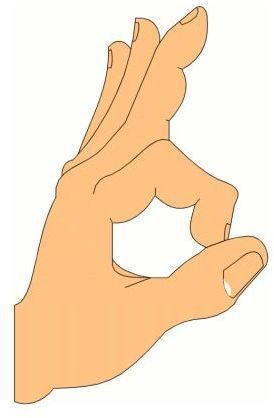Conscious Body Language - Gestures in Different Cultures: From A-OK to Air Quotes
Certain gestures and facial expressions are a form of communication using body language rather than the spoken word. Although non-verbal communication is used throughout the world, the meaning can vary considerably from country to country.
A-OK
The gesture for A-OK is made by raising (usually the right) hand and forming a circle with the thumb and index finger, For emphasis, often a short, hammering motion is made with the wrist. This gesture is an example for how widely the interpretation can differ in various cultures.
Generally, the A-OK is just that, a sign of approval. But, in several middle and Southern European countries, with the exception of Spain and Portugal, the gesture is decidedly offensive, telling the recipient that he or she is a nobody, a zero (0). The meaning is even worse in Brazil, telling the other person he or she is an a…hole. The gesture is also extremely offensive in Turkey where it is used in connection with homosexuality. In Germany, the sign has both meanings, depending on occasion and context and in Japan, it is relatively harmless as it means no more and no less than simply “money.”
When the circle is placed over the nose with the nose peeking out between the thumb and index finger, it is a signal to indicate that a person is drunk.
Applause

To show approval and admiration the hands are often loudly clapped together. Hand clapping is mostly a group gesture and the habit dates back to ancient Rome and the Roman theatre performances. Hand clapping followed distinct rules and rituals to express the degree of pleasure or disapproval of the audience.
Today there are two variations to the original form of applause: the silent, noiseless hand clapping and the slow clapping. Soundless applause is also known as a “golf clap” because it was developed by spectators at golf tournaments who wanted to show approval and encouragement without wanting to destroy the concentration of a golfer about to line up his next shot. From that origin, silent clapping went to take on the meaning of criticism and sarcasm rather than approval. The British House of Parliament and some Asian nations do not clap at all.
Slow hand clapping is a form of disapproval and even heckling. Recipients of that particular form of non-applause are often politicians, most notably British ex-Prime Minister Tony Blair, as well as disappointing stage performers.
Air Quotes

Air quotes, which are quotation marks made with the index finger of each raised hand, accompany speech and often express the opposite to what is said, because they are gestures and expressions of sarcasm, irony or wit. The air quotes are often made to resemble the written quotation marks of the language the conversation is conducted in, or which is the mother tongue of the “speaker”. Therefore, the actual form can differ, but the meaning remains the same.
References
“Gesture and Thought”; David McNeill; University Of Chicago Press; November 8, 2005
“Bodytalk: The Meaning of Human Gestures”; Desmond Morris; 1994
Image Credits
A-OK Image: Public domain Clip Art/pdclipart.org/displayimage.php?album=29&pos=0
Applause Image:Duveau/www.clker.com/clipart-49611.html
Air Quotes Image: Tortillovsky/Public Domain/commons.wikimedia.org/wiki/File:Quoting.gif
This post is part of the series: Conscious and Involuntary Body Language
50-60% of communication is conducted by body language, whether conscious through gestures or involuntarily through reactions. Learn about differences, similarities and interpretations according to countries and cultures.
